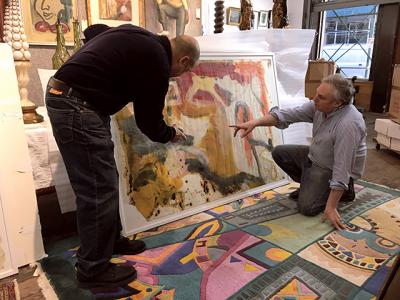Art Trove May Contain De Koonings

A Manhattan auctioneer claims he has unearthed six Willem de Kooning works from an abandoned storage locker in New Jersey. David Killen purchased the contents of the unit for $15,000 and says the finds could range in value from $10,000 to $10 million.
According to Mr. Killen, the unit was once owned by Orrin Riley, an art conservator who died in 1986, and his partner, Susanne Schnitzer, who took over the business until she died in 2009. It contained 200 artworks. Mr. Riley founded the Guggenheim Museum’s conservation department before starting his own Manhattan studio in the West 30s.
After a nine-year period during which Ms. Schnitzer’s estate and the New York State attorney general notified all of the clients who might have left works with the studio, those that remained were declared abandoned and cleared to be sold, Mr. Killen said.
Lawrence Castagna of Springs, a conservator and former de Kooning studio assistant, was asked by Mr. Killen to restore the works, all oil paintings on paper and newsprint dating from the 1970s with one possibly from 1960. “For 35 years they had been kept in a folder with glassine over them. I was hired to remove the glassine to see what they were,” he said on Tuesday.
Mr. Killen chose him for the restoration work because he also had worked in Mr. Riley’s studio, a job Mr. Castagna found through the recommendations of de Kooning and his wife, Elaine de Kooning.
When he saw the six works, he knew right away they were by the artist. “I took a look at a corner of one of them [not covered by glassine] and it hit me in the gut,” he said. Another expert Mr. Killen said he hired also agreed on the attribution, but opted to remain anonymous. “Anyone who knows anything about de Kooning wouldn’t deny what they were,” Mr. Castagna said.
He clarified that he is not an authenticator, as media reports have said, but that he could tell they were de Koonings from his experience working directly with the artist as well as later in Mr. Riley’s studio, where he recalled several drawings from this period being restored or repaired. “Orrin Riley never had anything that wasn’t important in there,” he said.
De Kooning does not have a catalogue raisonné, a complete list of works that scholars and his foundation have agreed are authentic. The foundation also declines to authenticate work, so confirming its bona fides is tricky. The six works are unsigned, which is not unusual.
Mr. Castagna was still in high school in the mid-1970s, but began working in de Kooning’s studio in 1982 during the artist’s “Ribbon Painting” phase. He started with Mr. Riley in 1986.
He took the drawings back to his studio in Springs to remove the glassine, “some 500 feet from where they were made,” he said. They are now back in Mr. Killen’s gallery, and some were unveiled at a reception on Tuesday night.
Mr. Killen has given estimates of the value of the works — which differ in size, style, and support — from $10,000 to $10 million, telling WCBS this week that the low estimate is probably too low and the high estimate too high.
There are three large-format works measuring around 40 by 60 inches, an unusually large size for works on paper; the rest are on newsaper. Mr. Castagna said that Elaine de Kooning told him that the newsprint paintings were the result of de Kooning’s not wanting to waste paint as he cleaned his brushes at the end of the day. He would put newspaper on the floor and run the brushes over them. “People who came to his studio said they liked the resulting images and he would give them away.” Some have been recently sold in the range of $60,000 to $80,000, he said.
Historically, de Kooning’s later work has been devalued compared to his work from the 1940s and ’50s. Lately, however, scholars and the art market have rediscovered de Koonings of that period and the prices of some canvases have increased into the millions. This has also resulted in some skepticism in the marketplace, as noted by artnet News, which quoted one market watcher as saying the timing of these findings might be “a little too on the nose.” Mr. Killen plans to sell the works in auctions beginning in October.
